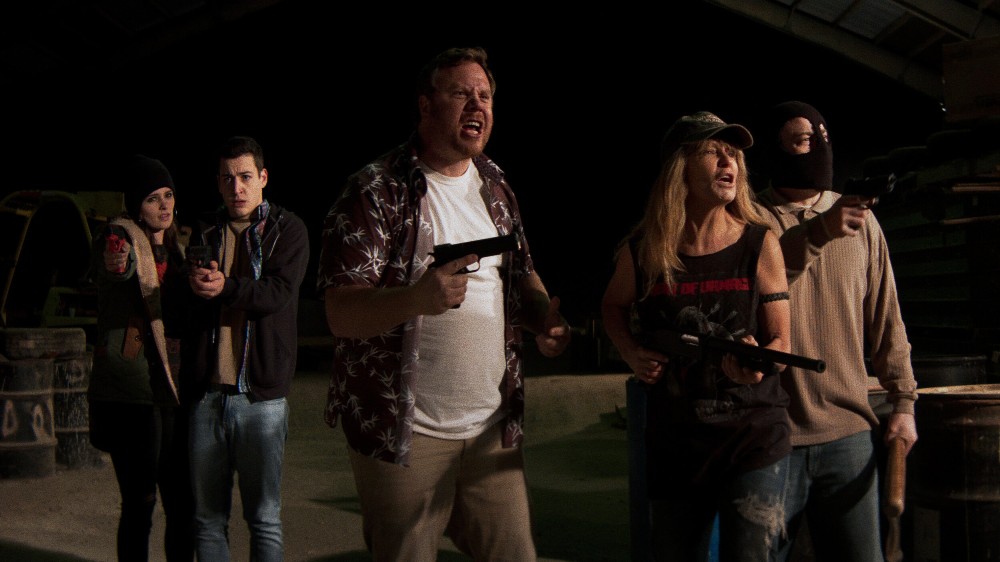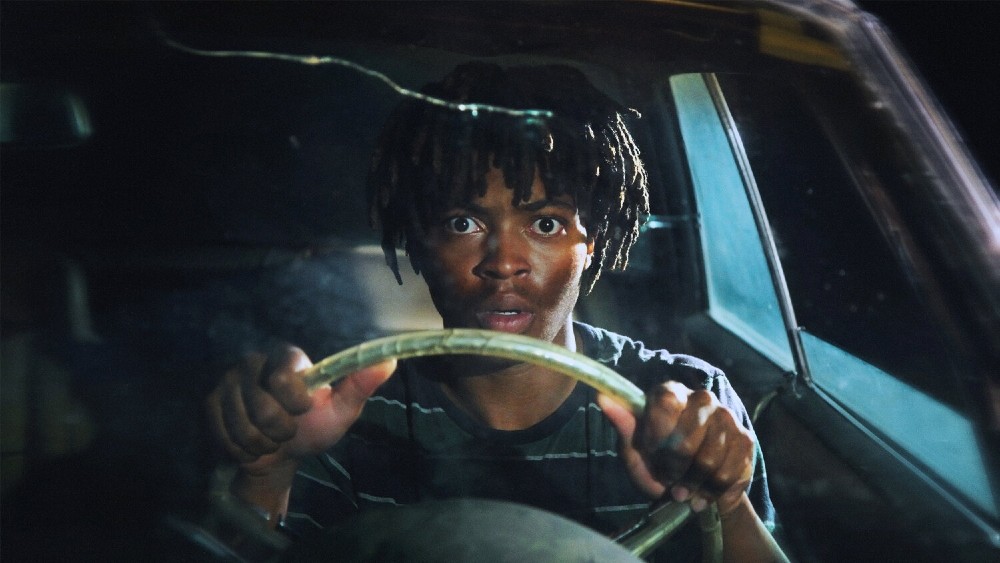
When you watch Manuel Crosby and Darren Knapp’s debut film, First Date, you know you’re in for something special. While it has the indie DIY spirit that has led to some great filmmakers like Tarantino, Soderbergh, Robert Rodriguez, and many more, it also shows off the true spirit of collaboration when people making a movie together are really enjoying the filmmaking process.
First Date stars newcomer Tyson Brown as Mike, a shy unassuming teen who somehow manages to score a date with the kick-boxing firecracker, Kelsey (Shelby Duclos). He doesn’t have a car to pick her up, but he’s convinced by his friend, Brett (Josh Fesler), to buy a car online, which turns out to be an old 1965 junker that barely runs. Over the course of Mike’s night trying to get to Kelsey’s house to pick her up for the date, he ends up running across a group of shady individuals who want Mike’s new car for various reasons, including a hilarious criminal “book club” led by Jesse Janzen’s “The Captain.”
Manuel Crosby is an interesting young filmmaker who co-wrote, co-directed and co-produced First Date with Knapp, but he also acts as cinematographer, camera operator, film editor, and he even was involved in the music. It’s been a long time we’ve seen one person take on so much work on a movie, but the proof is in the pudding, as the results are fantastic, a truly entertaining single night action-comedy that stands up to anything else currently in theaters.
Below the Line got onto Zoom with Crosby for the following interview, where we learned pretty quickly that his enthusiasm is quite infectious.
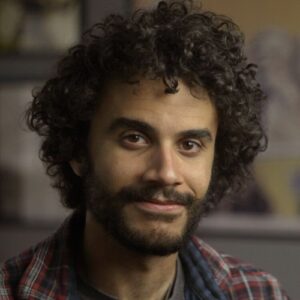
Below the Line: I was surprised as I watched the credits how much you actually did on it from operating the camera to editing, even doing the music. So how did this whole thing come about? Is this all regional? Where are you based?
Manuel Crosby: I’m based in Northern California, and we shot the movie in Darren and I’s hometown of Valley Springs — Darren still lives out there — and the genesis of the idea came out of that. We always would think that’s the region that pops into our heads when we think of film, learning how to make movies. Every short film we had done over the last 10 years together was shot in and around the area, and you know it like the back of your hand. So that’s number one. And then I was down there watching movies one day. Darren and I would hang out and watch movies. We bonded over similar movies of the ilk of what we ended up making.
I was having car problems, and I was just complaining one day over breakfast. I always buy these used cars that seem great, and then they fall apart. Why is it so hard to know how somebody treated their car and what they did with it before you got it? It’s just impossible. So that’s part of the idea of his first car, and it had such a checkered insane backstory, that it landed him in some serious trouble all in one night. And we were throwing ideas back and forth, and by the end of that breakfast, we pretty much had the plot outline of First Date. I got really excited, I was like, “This feels like those movies we’ve been watching, and that we love,” and then we started fleshing out the characters and finding the arcs and the ways that they come in and out of each other’s lives and converge at the end. And it was like, I was feeling a feeling in my bones, I was seeing the images, and it was just like, “We oughta make this movie.”
And then to your first point, I love all parts of the filmmaking process. I’ve been doing it for a while, and Darren kind of comes from a similar DIY background. So we knew between the two of us, even on the worst day, where we had no additional crew besides us, we could still shoot a scene. So that gave us the confidence to actually go ahead and jump into making the film. Since I really do love being behind the camera and cutting things together, it wasn’t a burden. It was a creative possibility. We always credit Robert Rodriguez for his inspiration and in this type of filmmaking as well. I was rereading his book and listening to interviews with him during the production, and it got me through some moments where I didn’t know if we could pull it off. I’m super grateful for that to be out in the world, because it inspired me, and I hope it inspires many other people as well.
BTL: Also, who is “LK”? I saw those initials a lot during the closing credits.
Crosby: She was primarily our special effects supervisor and designed and built the rigs that anytime blood would fly or things would explode, she was in charge of that. She, along with most other people you’ll see in the crew list, were doing all kinds of multiple jobs, wearing multiple hats. Everybody, including me, was a PA, was a grip. We’re unloading the equipment and loading it in and making food and being extras if needed. It was a real group collaboration, just a real family vibe with everybody pitching in and working together. Some of my favorite moments — I’m sure a lot of filmmakers feel this way — were after we were done shooting. We were all eating dinner, hanging out, just bonding and basking in the enjoyment of what we shot that day or glad that we overcame that particular challenge on that day, all feeling tired together and laughing together. I’ll never forget that stuff.
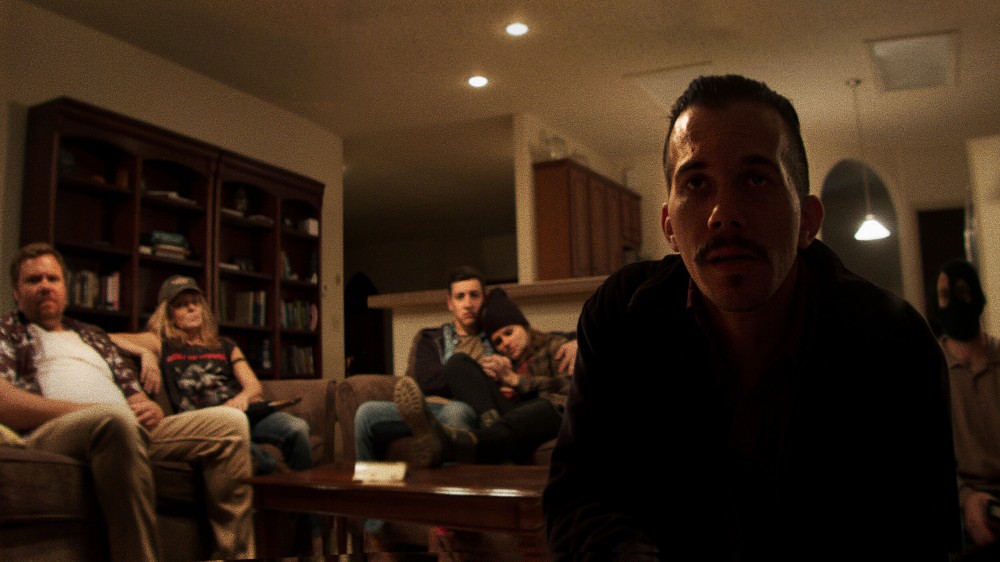
BTL: We’re fans of the unions here at Below the Line, but there’s also something to be said about a movie like this where everyone is chipping in to do stuff. I remember speaking to Sissy Spacek* many years ago, and she told me that on Badlands, she’d be carrying paint, which you could never imagine being the case now. (*Name drop!)
Crosby: And it starts from necessity, right? You have this movie, you want to go out and make it, but you don’t have the resources. What do you do? You gotta find a way to get started, and to do something like what we did requires so much generosity from so many different people, who just want to be a part of something cool and who care about you as a person enough to want to help you out. Our community, the community we had around us, was huge in helping us make our first movie. We never could have done it without them.
BTL: I do want to ask about casting, because the entire cast is amazing and not just Tyson and Shelby as the two leads. The entire “book club” has so much personality, and you could tell that they’re really into their characters. Where did you find all these people?
Crosby: A few of them were friends already like Nicole Berry, who played Sergeant Davis, a good friend of mine, and Ryan Quinn Adams, who was Vince in the book club, the big angry guy, he was already a friend. Many of the others we met or worked with in a serious capacity for the first time. Almost everyone was out of Sacramento, California. A few people were local to the Calaveras County area where we shot the film, but there are many more actors in Sacramento. The guy in the first scene, Todd Goble, was the only person from LA and he was a friend of mine from a while back. He was gracious enough to come out for a day and have a good time shooting a scene with us. It was important for us to cast mostly locally, because we were shooting the movie in an unorthodox way. We had simply all kept our day jobs. We couldn’t just walk out from work and shoot this movie. We had to be able to flex things and spread it out over time, and so we needed people who weren’t too far from Valley Springs, who were cool with making the drive, and then we would work with them on their schedules as well to make it easy on them. So it became kind of a balancing act, but most importantly, I think, is there are just a lot of talented people up here, who really deserved a chance to be in something fun, something cool that they were passionate about. I’m so happy that they got that chance, and they all killed it top to bottom, you know, everybody blew us away. They brought so much more to their characters than we ever even thought from dialogues. Some of them even had very creative wardrobe choices they brought to get into the characters, and they were so excited. Rehearsing with them was a blast. Shooting the scenes was even better, and I couldn’t be with a better group of people to make this movie with.
BTL: It’s amazing to hear you were shooting that way, because the continuity is so great, which is important when you have a movie that takes place in one night, and you’re shooting it in pieces, it’s hard to imagine you keeping the characters looking the same in the same clothes.
Crosby: It was a trick, and editing does a lot. I will say that if you watch very closely, you’ll see that Mike’s dreads grow from the beginning of the night until the end, because the experience aged him so much. But if it’s the only way you can make the movie, you just roll with it. Keeping a simplicity to it … that probably sounds weird, because the events are so complicated, but there is a simplicity to it as well, that does help with keeping continuity, if you’re on a limited budget, and you don’t have a lot of support to keep eyes on continuity specifically. Shooting something in one night, it helps if there’s only one shirt that each person has to be wearing. Of course, you to remember if it’s supposed to be bloody or dirty. Beyond that, it was a juggling act, for sure, but I don’t know, I guess it just became something we got used to.
BTL: Were a lot of the actors fairly experienced with making movies or had many of them not really done much before this?
Crosby: It varied. I think Jesse Janzen, who played the captain, the main villain, I think he was probably the most experienced actor on the set. And then down to Tyson and Shelby and Scott Noble, who played Dennis, Angela Barber — who played Ricky with the baseball cap — I don’t think they had done much before. There were people who had done multiple short films in between. I don’t think there was a whole lot of feature film experience on the set, but we had a range. It was really cool to see how those more experienced actors like Jesse and Leah Finity, who played Darla, would almost mentor the younger actors in the middle of their scenes, or the less experienced actors, and they would bring the best out of each other. But on the other side of the coin, with Tyson, Shelby and Scott no particular you get a spontaneity, from people who don’t know certain rules about movies that brings in a whole other energy to it that comes across in a really cool way on the screen. So it was a great group of people, and we really got the best of both worlds.
BTL: I really love the entire cast, and this is one of those movies where I think that I’d love to see this entire cast in another movie, maybe each playing different characters, but they really meshed together well.
Crosby: I really hope to have the opportunity to do something like that again with them. Part of it is because we’ve developed that family bond, and I really loved working with everybody here. But they’re all so talented, and so unique as performers and as people. I look forward to the day when I can see them in some huge movies and think back and like, “That’s where they started. Oh my gosh, that’s really cool!” I think it’s gonna happen for everyone, and I’m really, really excited and grateful to them for coming along on this journey.
BTL: Especially Vince. When I see him in another movie, I’ll be, “Oh, yeah! That guy who yells a lot!”
Crosby: I’ll tell him you said that — Ryan Quinn Adams is gonna be really happy that you said that.
BTL: He really made me laugh so hard. You can just tell that he’s really into it. So how did you find that beater of a car for Mike to drive around and actually get it so that it could take part in chases? If this were a bigger movie, you’d use the body of a beater and put it on a souped-up race car, I’d imagine.
Crosby: So with the car, we actually found it on Craigslist, our producer, Brandon Kraus, found it. We had been looking high and low trying to figure out where do we get this car? Can we borrow one from a friend? Nobody really has one? Okay, like let’s try to buy one or rent one. Nothing was really working out. Some of them were too beat up. Some of them looked too cool. We found this one, the 1965 Chrysler New Yorker, that looked like it was in bad enough shape, but then when you look at it under the right lighting, it has a really beautiful vibe to it. I mean, the engine sounded so cool when you started it up. It had a 440 engine under the hood, so it had a great engine, and it could move. It was a great metaphor, even for the main character’s journey of being written off and even writing himself off, at first glance, and then realizing his true value and his true potential. You kind of get the same thing with the car.
Keeping it running was a different story. And again, LK was a huge contributor in that, because she is also a very skilled mechanic. So that car was constantly dying on us. I mean, there’s a shot in the movie where it dies coming around the corner the first time Mike’s driving it. That was not in the script. It happened while we were shooting, so the three of us got from behind the camera and pushed the car out of the intersection, and then I just kept rolling, while Darren jump-started it. It was leaking coolant at one point. It started with all four hubcaps, but they would fall off at various times of shooting, so I think it ends with zero. But it was a challenge keeping it running. Eventually, we shot the scene, and LK had fixed so many problems with the car that it ran better when we were done than when we started. It was a journey to be sure, but it was a lot of fun. Another funny little detail was that it wasn’t quite as beat up on the outside as we wanted it to look. We didn’t want to completely destroy it anymore, so I actually painted a stain on the front that was meant to look like oil. It was actually steak sauce. I would have to repaint it anytime it rained or got really humid and washed off on the outside.
BTL: I want to talk about the shoot-out, but I want to avoid spoilers obviously. How long did it take to shoot and edit that scene together? It seems like there are so many pieces that it could take forever, especially if you have certain actors coming in and out for certain days.
Crosby: That was on the calendar, very, very far in advance, and we were begging everybody, “Please, please, be there.” There were a number of scheduling difficulties we had to work out, but most of that was shot in five days. We came back and did a few pickups like for an hour or two with a certain actor or whatever, just to get reactions if needed. But all of the blank-firing weaponry was captured in three days. So that all involved us, first of all, Darren and I finding the location, which was kind of a fluke. It had been written to take place in an airport hangar that would have just been empty. So this worked way better, once we stumbled across this location, which is actually where Darren used to work as a kid. We get a sense of the geography. We find all these features as we’re walking around and kind of block it out. I blocked out the actors’ movements on paper with these overheads. We got them there, drilled the movements, just one day with no weapons or anything, just to get kind of like a dance just learning the motions, worked with our gaffer, Cody Martin, who came out for this scene and the car chase stuff only, to figure out how we’re going to light this huge space and storyboard everything, plan, schedule. When it came time to shoot, we couldn’t afford enough guns and blank ammunition to go around the entire group. So we only had I think we had four handguns, one uzi, and one shotgun, and enough ammunition to do one and a half takes of every shot that involved low gunfire. So I had to tally all of that out on the storyboard and count it out and be like, “Okay, did we get that on take one? No. Okay, well, I guess we can do another take.” That provided a lot of intensity for the performances, because everyone was on edge, everybody was on point. And we got to capture it for real. We got to do it safely with some of the best armorers in the world, ISS Props, which was like an incredible, incredible experience. And then we have the effects of the bullet hits and things LK was putting together to capture as much in-camera as we could, so we had minimal CG at the end. But again, going back to Rodriguez, El Mariachi, he used a lot of similar tricks to spread his resources as far as they could go. So we definitely did the same thing. At the end of that shoot, as we’re striking the set, and the sun was coming up, it was this feeling of like, “Wow, we did something really cool.” I don’t know if we’ll ever do that again. But man, that was like, what we always dreamed of when we first got into film. It was a blast.
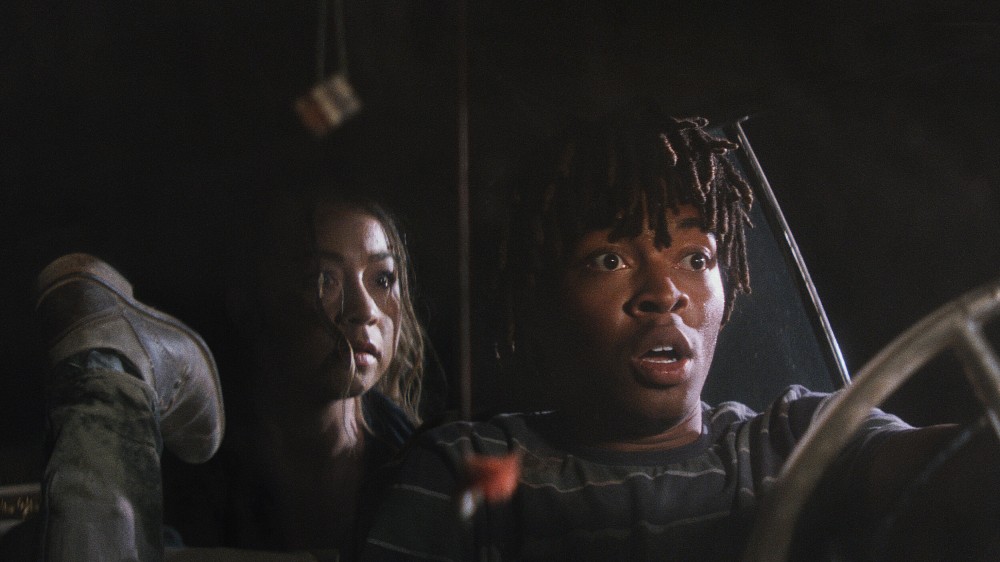
BTL: How long did it take to edit it all together and make it into what it came became. Because it seems that that’s another year right there, at least.
Crosby: I mean, I have been editing that scene together while we were shooting, actually, to see if certain gags were working right, and then, from there, the rough cut overall took… I think, in May 2019, we had it done. We shot that scene in January 2019, and from there, we hooked up with another editor in El Paso, Texas — Zach Passero. I remember he said, he watched the scene, and he was like, “All the pieces are here. All the shots are here in the right order.” And it was just tightening it up to add more intensity at that point. It was a challenge to figure out especially during dialogue stuff, who to cut to and when and laying out the geography [which was] much more complicated than some of the other scenes in the movie. But you just feel it out as you’re doing it, and you can go through trial and error.
BTL: Lastly, I want to ask about the music, because you’re obviously involved in that as well. It seems like there’s a lot of music but it’s all original even things like the song on the 8-track being something you put together yourself. There’s no needle drops, as they say. What was involved with putting together that score?
Crosby: In that script, we had actually written that the 8-track tape was the Greatest Hits of Santo and Johnny, a song that Mike and Kelsey bonded over was “Sleepwalk,” which is a relatively famous song. I didn’t know much about music licensing. You probably couldn’t get it, but I was like, “Let’s write it in. We need something,” so when we shot the scenes, we shot two tapes. We shot one that said Santo and Johnny, and then we would shoot one that said Jackson and Jackie which is a made-up band. As we were writing the script I was imagining that sound, and I listened to a lot of music, and I was just dreaming, like, “What if we created something? That would be really cool.” Again, inspired by Robert Rodriguez. I was not a skilled musician or anything, but I knew a little bit about music, and I was like, “Maybe, I don’t know.” Down the line, I connected with some friends up here where I live now in the Tahoe area, Noah Lowdermilk and Kevin Kenntera, who are two really talented, awesome musicians. They record their own music and all this stuff. They wanted to work on the music, and I explained, “What if we recreated that style, or found our own way in?” That was the jumping-off point. We kind of evolved it into this– we called it a “Cowboy SpongeBob” — but it was like its own flavor. They kind of inspired me. “You have a guitar, try to do this slide guitar stuff.” So I got a little brass slide from the music store, and I was like, “Man, that sounds cool. Yeah, I can do this.”
So we start recording, and then it’s like, “I’d been dreaming while we were shooting the movie and was like, “What if the score was done by that band, but they got all anxious? Like, what would that sound like? How can we do something like that with these same instruments? So we started messing with that. And it sounded so cool and weird and different. I started falling in love with it, and it was awesome. That was one of my favorite parts of the experience, because it was so new and exciting, being involved in making music with these people who are really good and know how to do it. And then, of course, we fill out the soundtrack with a few rock songs and things like that from other personal friends of ours. That was really cool to let them be a part of the process as well. But, man, that music was such a fun journey, and one of my highlights of the whole experience for me.
BTL: I look forward to seeing what you do next. It’s funny, because I also have an interview this week with Chris McKay, who directed that $200 million Chris Pratt movie, The Tomorrow War, which will be on Amazon this week, but it’s interesting that your smaller, cheaper DIY film will play in theaters but that won’t.
Crosby: I think Amazon probably doesn’t have any complaints about that, but damn, we’re excited to get this thing out in theaters and for people to see it. So thank you so much for your time.
First Date is out in select theaters and available on digital right now.

